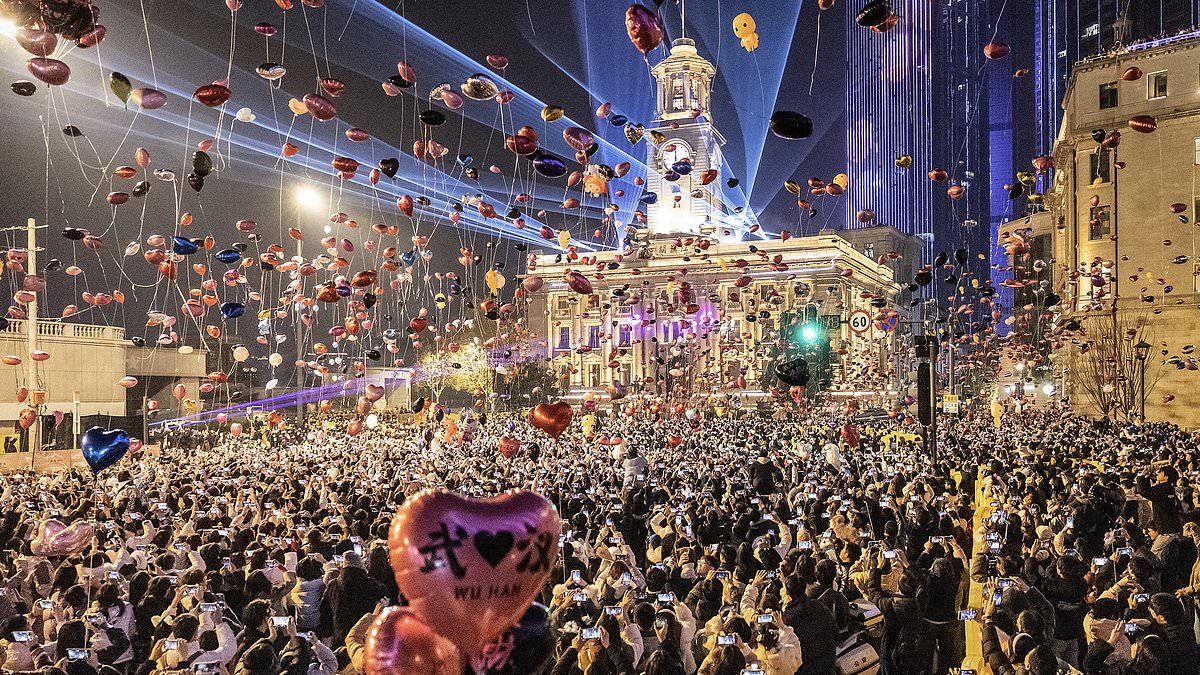The Chinese city of Wuhan became famous across the globe in 2020 as the epicentre of the deadly Covid-19 outbreak, which shut down much of the world and claimed millions of lives.
Five years on, the city is thriving, with shopping districts bustling, food markets brimming with people and roads gridlocked, as though the horrors of the pandemic never happened.
The megacity of 11 million people had a far higher mortality rate than the rest of China, with the first cases detected in December 2019.
On January 23, 2020, Wuhan sealed itself off for 76 days in an effort to stop the mystery virus spreading, ushering in China’s zero-Covid era of strict travel and health controls and foreshadowing the disruption which would grip the rest of the world.
Now locals say that the city’s association with the virus and increased prominence has actually had a positive impact, with more tourists visiting in the wake of the devastation.
‘Now everyone pays more attention to Wuhan,’ Chen Ziyi, a 40-year-old resident said. ‘They say Wuhan is the city of heroes,’ she added in apparent reference to the city’s efforts to shut down.
Visiting the city, reporters saw people walking dogs and promenading along the upmarket Chuhe Hanjie shopping street in designer outfits while others queued to pick up bubble tea orders, as they do in any bustling metropolis.
Locals thronged the Shanhaiguan Road breakfast market, munching on bowls of noodles and deep-fried pastries, and many people happily walked around without masks.
At the start of the year, huge crowds gathered on the city’s previously empty streets, releasing heart-shaped balloons proudly emblazoned with the city’s name as they celebrated New Year’s Eve.
‘People are moving forward, these memories are getting fuzzier and fuzzier,’ Jack He, a 20-year-old university student and Wuhan local, told AFP.
He was in high school when the lockdown was imposed, and spent much of his sophomore year taking online classes from home. ‘We still feel like those few years were especially tough… but a new life has started,’ he said.
But, take a closer look and some signs remain of the city’s darkest days remain.
At the former site of the Huanan Seafood Wholesale Market, where scientists believe the virus may have crossed over from animals to humans, a light blue wall has been built to shield the market’s closed-down stalls from view.
Censorship, as across Communist-ruled China, remains tight, with journalists looking into the effects of the pandemic trailed through the city.
A worker said the market’s managers had sent security camera footage of AFP journalists out to a mass WeChat group of stall owners and warned them against speaking to the reporters.
At least one black car followed AFP journalists across the city, including to the new market.
When AFP visited, workers were putting up Chinese New Year decorations on the windows of the market’s second floor, where a warren of opticians’ shops still operates.
Over a dozen vendors at the aptly named New Huanan Seafood Market refused to speak about the market’s past.
The owner of one stall told AFP on condition of anonymity that ‘business here is not what it was before’.
There is nothing to mark the location’s significance – in fact, there are no major memorials to the lives lost to the virus anywhere in the city.
At the former site of the Huanan Seafood Wholesale Market, where scientists believe the virus may have crossed over from animals to humans, a light blue wall has been built to shield the market’s closed-down stalls from view.
Official commemorations of Wuhan’s lockdown ordeal focus on the heroism of doctors and the efficiency with which the city responded to the outbreak, despite international criticism of the local government’s censorship of early cases in December 2019.
The market’s old produce stalls have been moved to a new development outside the city centre, where it was clear that the city was still on edge about its reputation as the cradle of the pandemic.
One of the few remaining public commemorations of the lockdown is next door to the abandoned Huoshenshan Hospital – an unassuming petrol station that doubles as an ‘anti-Covid-19 pandemic educational base’.
One wall of the station was dedicated to a timeline of the lockdown, complete with discoloured photographs of President Xi Jinping visiting Wuhan in March 2020.
An employee told AFP that a small building behind the facility’s convenience store housed another exhibit, but it was only open ‘when leaders come to visit’.
The Huoshenshan Hospital, which was built in just days as cases spiked in early 2020, was once celebrated as a symbol of the Chinese city’s fight against the virus.
But the hospital now stands empty, hidden behind more recently built walls – faded like most traces of the pandemic as locals move on and officials discourage discussion of it.
It is widely believed that the Covid pandemic began in Wuhan, though there is debate among epidemiologists as to whether it emanated from a wet market or the world-leading coronavirus research laboratory located in the city.
The Wuhan Institute of Virology (WIV), where many scientists believe Covid is may have originated, had been looking into viruses that were distant relatives of Covid around the time of the outbreak.
